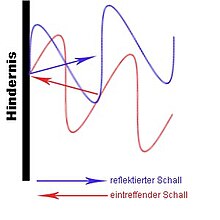Print jam
A pressure accumulation effect occurs when sound is reflected off an obstacle and superimposed on its own reflection. This leads to a locally limited increase in the sound pressure level towards high frequencies.
General
A pressure build-up always occurs when sound hits an obstacle that is larger than the wavelength (lambda λ) of the sound signal. As a prerequisite for maximum pressure build-up, the surface of the obstacle must be flat and rigid. A resilience of the surface causes phase differences in the reflection and thus possibly a modulation of incoming wave trains of different frequencies among one another. A roughness of the surface creates a scattering of the sound, similar to that of the oblique incidence, possibly without an increase in level.
The sound is reflected in phase at straight incidence on flat and rigid surfaces and a maximum increase in the sound pressure level of 6 dB is obtained close to the obstacle , since the amplitudes of the incident and reflecting sound add in phase (coherent); see figure above. The frequency at which the pressure build-up occurs depends on the size of the obstacle.
It is calculated as follows:
Frequency f , unit: Hz = speed of sound c , unit: m / s / size of the obstacle d , unit: m
Here is an example at 20 ° C (the speed of sound at 20 ° C is 343 m / s) and an obstacle d = 30 cm in size:
Thus, the maximum pressure build-up is reached from a frequency of 1143 Hz and the sound pressure doubles for all frequencies above this frequency, which corresponds to an increase in the sound pressure level of 6 dB.
If the sound is incident at an angle (lower figure), it is reflected in a different direction and the pressure build-up is reduced; the pressure build-up also occurs if the sound is not incident at right angles to the obstacle.
Occurrence of the pressure jam
the following conditions apply:
- Audible pressure build-up (approx. + 3 dB) from: λ = 4 × obstacle / membrane diameter
- Max. Pressure build-up (+6 dB): λ = obstacle / membrane diameter
Explanation: A wave already reaches its maximum amplitude at λ / 4. Therefore obstacles of this size are relevant for reflections . As soon as the obstacle is larger than λ, the wave is fully reflected (with an ideal reverberant surface). In the case of even larger obstacles, the pressure build-up does not increase any further, but the acoustic shadow behind the obstacle increases.
If you look very closely, Jörg Wuttke says there is a transient process of the pressure build-up, which without damping leads to a level increase of 10 dB at λ = membrane diameter and only slowly settles down to the mean value of +6 dB. This transient process is attenuated with good microphones.
see also pressure microphone , boundary microphone, pressure accumulation effect and area dependence
Use of the pressure jam in sound engineering
A pressure jam occurs with all microphones of the pressure receiver type . The obstacle here is the microphone capsule with the membrane. The larger the capsule diameter d , the lower the cut-off frequency of the pressure accumulation effect at a given speed of sound c :
The pressure build-up effect is sometimes acoustically or electrically compensated for with pressure microphones, as it is not always desired - which is known as free field equalization .
The special design of the boundary microphone enables targeted use of the effect . Here the small microphone capsule is installed flush with the membrane in a flat housing, which is then placed against a boundary surface (floor, wall, ...).
Thus, the principle of pressure build-up in the pressure receiver (microphone with omnidirectional characteristic) is extended to low frequencies by installing it in a large area.
This is used, among other things, in the bass drum, bass instruments, grand piano recordings, voice recordings, theater, stereo recordings (e.g. interfaces in AB setup).
A pressure jam can often be noticed in discos or smaller clubs, for example when walking from the dance floor to a wall opposite the loudspeakers. The bass of the system is significantly louder there. Here the obstacle (the wall) is so large that the pressure build-up also clearly occurs at low frequencies.
literature
- Thomas Görne: Sound engineering. 1st edition, Carl Hanser Verlag, Leipzig, 2006, ISBN 3-446-40198-9
- Thomas Görne: Microphones in theory and practice. 8th edition, Elektor-Verlag, Aachen, 2007, ISBN 978-3-89576-189-8
- Horst Stöcker: Pocket book of physics. 4th edition, Verlag Harry Deutsch, Frankfurt am Main, 2000, ISBN 3-8171-1628-4
See also
Web links
- Microphones in the spherical sound field - far and near (PDF file; 90 kB)
- Pressure build-up in microphones with omnidirectional characteristics
Individual evidence
- ↑ Eberhard Sengpiel: Microphones in the spherical sound field. January 1995, accessed January 10, 2020 .
- ↑ Thomas Görne: Microphones in theory and practice . 8th edition. Elektor Verlag, Aachen, ISBN 978-3-89576-189-8 , 3.1.3 b) Pressure accumulation, p. 39 .
- ↑ Jörg Wuttke: Omnidirectional condenser microphones. 1984, accessed January 13, 2020 .







